Text
Why Digital Access is Starting to Become a Daily Necessity
There is a reason why millennial today have stereotypes of not being able to put down their devices at all, and that may not necessarily stay a negative viewpoint forthcoming. Technology is starting to become important in our everyday lives; it connects us socially, which we would not be able to live without in today’s society. Being social doesn’t just help benefit our own personal gains, it helps us with situations of emergency or crisis, and it helps communities as well. This is why the digital divide still exists, and may always exists if we don’t continue to push for digital equity.

Source to image, link here
The best definition of the divide that can be explained universally is:
On a very fundamental level, the digital divide describes a negative space. Embedded in the term is a sense of urgency that implies a need to take action to fill this space. (Pazurek & Feyissa, 2015)
This makes it very universal and a timeless definition. A divide on technology has always been around as long as technology has been invented. However since being digital has started to become more beneficial to important lifestyles, like jobs and education, the term digital divide is used to talk about the individuals that do not have access to as much digital resources and why that is extremely unacceptable. The complexity of the social issue does not particularly apply itself into limited examples. There are many factors that can be a reason why there is a digital divide: age, wealth, location, to name a few. The levels of divide don’t also have to be unreasonably low and high. This is why the definition above is very simply put and is something that a lot of individuals can passionately resonate with.

Source to image, link here
So digital equity is the concept or movement that branches off of the social issue of the digital divide. A well-put definition of digital equity (that also discuss a factor in the concept) is:
Digital equity refers to whether people can access and effectively use the technology necessary to participate in modern society. Another phrase, “digital inclusion,” denotes efforts to remedy deficits in digital equity. Simply put, digital equity is what cities and states want, and digital inclusion is the work they and their partners are doing to create it. (Quaintance, 2018)
I think Quaintance’s article really describes digital equality in a very economical standpoint. He also brings up the factors that are external and may not be fixed, such as infrastructure and location, and the individual’s comfort level to the digital device they are using, or the necessity of what they need. A example from personal experience is that someone who may use the internet at home as a leisure, in comparison to someone who may work at home and has an office there. The picture above can be a great example of this external factor: give everyone a good outcome, instead of giving them all the same article.
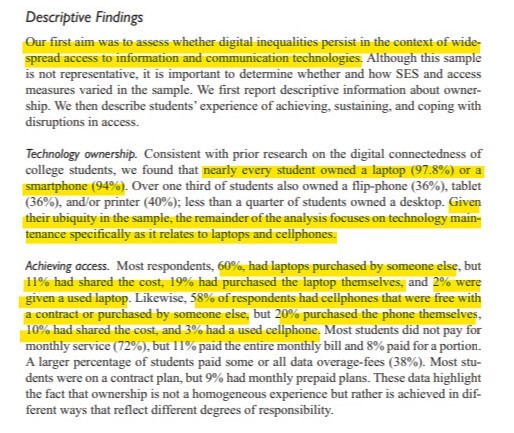
Text is sourced from (Gonzales, Calarco, & Lynch, 2018)
A good example is the quantitative research that had been done by Amy L. Gonzales, Jessica McCrory Calarco, and Teresa Lynch in 2018. They studied into the digital divide and the inequality of technology within a campus. The results that I highlighted above show us what they had been aiming for in the data and what the percentage results were. While many students had a laptop and smartphone, there were differing levels of responsibilities that each individual may had to have gone through in order to receive their connection to the digital world.
Access to information and communication technologies has expanded dramatically in recent decades, but technology-related inequalities persist. (Gonzales, Calarco, & Lynch, 2018)
Their findings are a great example of how the varying degrees of the divide can still be related to many individuals today. It is not a matter of just simply being too poor or rich for technology (but it is included), it is the varying responsibilities and necessities of being able to maintain a digital connection.

Source to image, link here
Digital divide and digital equity are two peas in a pod. Digital equity is the lawyer speaking while the digital divide acts as the evidence. They are both extremely important today, as again, jobs, education, and other important day to day functions rely on being able to access the level of digital comfort individuals need in order to not fall behind.
A good example as to why we should push for some digital equity is that it can offer opportunities to those who stereo typically were not the ones thought to enjoy it.
For ChickTech, that means intentionally targeting a diverse demographic for participation in their year-long program of workshops and activities. Schwass says that engaging women and girls in technology requires an emphasis on creativity, design, and thinking outside the box in addition to building relationships with peers and mentors.
“Girls are excited when they see tech isn’t just about sitting behind a desk,” Schwass says. As girls who built robots, LED bracelets and tote bags, mobile apps, and websites said, “This is so much cooler than we thought.” (Smith, 2018)
Being able to create programs like help those who are usually looked down upon, or looked at with a disadvantage. When we bring in new forms digital equity and push for new movements, we are balancing the outlook for many individuals who may have not perceived themselves of every being able to achieve these digital feats.
0 notes
Text
Discussing Digital Citizenship
What is digital citizenship?

Directly from the article, link to article
So there you have it, the most updated textbook-like definition of the subject of digital citizenship. What does it mean though? How are we imposing these norms and responsibilities, on top of empowering the usage of technology? Who are we trying to impost on: kids, adults, elders?

Ottesen, Julia, on EDSCOOP, Oct 1, 2018
Well, learning how to use technology responsibly has always been a controversy at all ages, from privacy concerns to cyber bullying, imposing norms will always result in someone taking the advice to heart. Anyone should be able to learn digital citizenship, as long technology keeps on advancing and changing, and the necessity of being digitally literate starts to work its way into every walk of life.
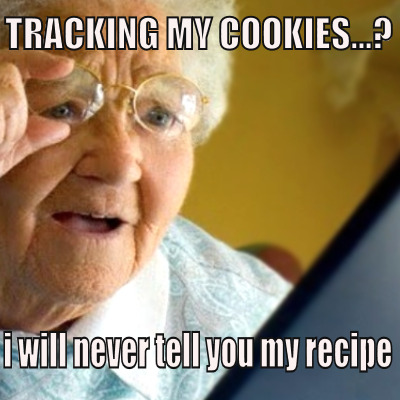
What I would tell someone what digital citizenship is that it is not purely a privacy concern, but almost a web of what to do and say on the internet to ensure the efficiency of what technology has to offer. The 6 curriculum that the edscoop article also discusses are:
Media balance and well-being
Digital footprint and identity
Privacy and security
Relationships and communication
Digital drama, cyber bullying and hate speech
News and media literacy
Each of these curriculum are constantly changing, like the privacy and security concerns from Facebook had netizens scrambling and demanding Facebook have a delete function. When Facebook made the changes, individuals started making examples showing the masses how to delete and secure their information. This is one very precise example of being able to teach digital citizenship.
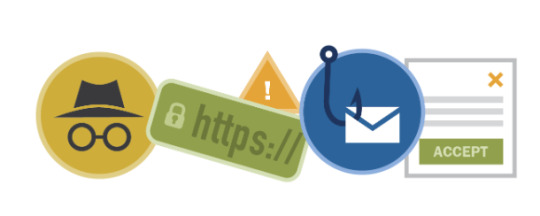
image taken directly from the quiz, link to quiz
The Pew Research Center also has a digital knowledge quiz, to test teens and adults on their digital knowledge of internet safety and general information.
Digital literacy vs. Digital Citizenship?
Digital literacy and digital citizenship can be very similar, as both rely on individuals willingness to learn about the online world. In literacy there is a part for judgement that has to be made as well, and in citizenship, it focuses very heavily on judging and weighing online experience. Digital literacy also touches more on cognitive skills and a few technical skills as well, while digital citizenship expands more towards basic principles and responsibilities. I think the two correlate well with one another, however digital citizenship seems more likely of the two to teach to wider variety of audiences and ages. Some digital citizenship curriculum, does in fact teach digital literacy as well, so they’re very close-knit.
Microsoft has a course for digital literacy, that pairs with other functions of being a good digital citizen, link to site
I think the 2018 Gleason & Gillern paper helps show how educators can get involved and foster digital citizenship in classroom settings; whether online at school, home, or anywhere. They use artifact quotes to help support their claims on how online factors help extend literary skills and increases social benefits, and go on to give examples of how teaching these skills was helping students online.

Gleason, Benjamin, et al., Digital Citizenship with Social Media: Participatory Practices of Teaching and Learning in Secondary Education, Journal of Educational Technology & Society, International Forum of Educational Technology & Society, 2018
In their twitter examples, they show that many of the students were more engaging socially on public issues. This will eventually lead on to when these teenagers become adults, helping them learn advocacy and passion for their own issues online. This is just the examples for teenagers, we can definitely foster adults/young adults to practice digital citizenship as well. Many of the adults today did not have these types of social platforms about 20-30 years ago, so it is safe to say that some may need some help in digital citizenship as well.

Taken from Dr. Josie Ahlquist article, link to site
In Ahlquist’s article, she states that the research is still very small in encouraging digital citizenship education within college students, which is why I believe I can make a few suggestions for educators that I have experienced have helped when it came to learning more on digital citizenship. I think with sites like canvas and other college social platforms, courses should advocate digital citizenship through syllabuses or in the case of online courses, should give information and sites to help students do individual research. Campuses could also require short mandatory courses like the ones for sexual assault or alcohol education, since it has students sit down and learn the drawbacks and benefits of their technology. I think it should go over the 9 elements:
Digital Access
Digital Commerce
Digital Communication and Collaboration
Digital Etiquette
Digital Fluency
Digital Health and Welfare
Digital Law
Digital Rights and Responsibility
Digital Security and Privacy
that appear in Ribble, Baily and Ross’ 2004 article.
link to article
In order to create a virtual space that will more than likely help people rather than cause destruction, we must make sure that individuals learn how to participate online. By making it more accessible to learn about how to speak online, how to hide privacy and protect your info, how to maintain virtual health, etc., we need to offer more to those who need help learning. It’s important for those who learn to help others online maintain good digital citizenship as well, that it why I think educational creators are essential online participators.
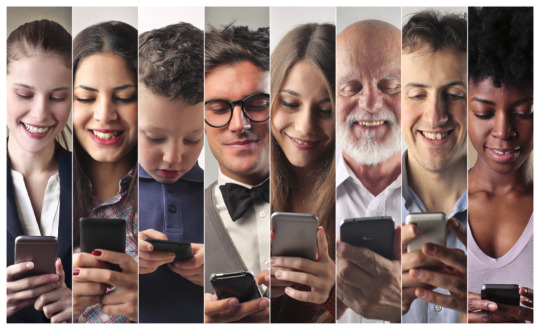
link to image site
1 note
·
View note
Text
Participatory Culture in Social Media
(Jenkins, Puroshotma, Clinton, Weigel, & Robison, 2009)

(Image from Ted Talk by Henry Jenkins, March 6, 2010)
Participatory culture as a study has been developed since the ideals of the printing press. As Jenkins states in his Ted Talk when he is going from one historical method of participation culture to the next; “We could carry the notion of participatory culture forward [...],” (Jenkins, 2010). This is a great way to put it, as he discusses the codes used by young people during the printing era, to the radio stations for subgroups like cub scouts, and to the zines made for sci-fi lovers. Each generation and form of mass communication is passing the baton to the next, developing new ways for individuals, particularly younger generations, to participate through platforms where they can express their ideals free from an institution.
I believe that the best definition for participatory culture is the relationship that each social individual has with their and others inputs of the occurring interests and sub categories taking place within the present. This does not only increase individual benefit, but the social benefit as a whole, as people discover what they can do for others as well as themselves. Especially for younger people, the emphasis of being affiliated is something that helps them as they grow older, as they can grow to be more passionate about the topics that they hold close to them from a younger age. It also helps them learn more about public morality, and what kinds of crowds would respond to their interests and feedback.
The research published MacArthur Foundation in 2009 has a good set of rules that defines the minimum of what participatory culture can be.

(Jenkins, Puroshotma, Clinton, Weigel, & Robison, 2009)
These are very simplistic mannerisms that you can see in the occurring social platforms today. The first one can be seen here on Tumblr, where people can post their art and receive feedback and respond to it as well. The second plays into the idea that the feedback would be positive, such as when a person can post their achievements and good a good response from the others that follow them. The third can be related to our course, and how we use twitter to find knowledge on articles posted from other users on the trends in social media. The fourth can be tied to specific communities, such as political and advocate groups, down to entertainment groups, such as a gaming or music community. The fifth, and the last one, can be the relationships and value that people feel from the feedback, posts, and messages individuals receive by participating. These 5 steps work together very well in how participatory culture functions, and how it is being used through social media.
An example that appears in chapter 4 of Hinton and Hjorth’s Understanding Social Media, discusses citizen journalism, which is an exceptional example of participatory culture, as it has benefits and drawbacks to the matter. Citizen journalism still being debated on whether or not it is liable method of journalism today, another form of mass communication moving on to social media. To boil down the definition of citizen journalism, it is when users, regardless of their backgrounds, participate in journalistic production and content, which can appear in blogs, post, and other forms of content, as long as the user is reporting on an event. Some argue that this is beneficial due to it being a quick way to display events happening on-site, which may be important to spread things in dire situations. The chapter states “ [...] when an event occurs where there are people to see it, there is frequently also footage, courtesy of someone’s ever-handy mobile phone.” (Hinton & Hjorth, 2013) With the growth of technology, it is easier to access coverage as a citizen, and many have adapted to these instances, such as some trends that grow on twitter by hashtags of a particular event that is happening in an area. Usually when you scroll through these it’s people posting videos of what is happening, and now some news sites are covering these topics through these citizens posts. While citizen journalism can be beneficial, it can also be extremely biased and unprofessional at some points. Plus individuals without editors or a team to support them are more vulnerable to the public as to what they post as well. The way that Hinton and Hjorth state it, “While information arrives faster, the quality of that information may be lowered or less considered.” (Hinton & Hjorth, 2013) This sums it up pretty well, as a good example for this is why tabloids and journalists fight for news breaking sources, is so that people don’t have to hear the same things over and over again on different sites.

After learning about participatory culture in social media, I’ve reflected on the benefits of being able to participate in activities and discussions of my own. I primarily use social media as a way to connect to my friends back in my hometown, while also maintaining friendships with people who are in my area as well. Like if I post scenic pictures of Minnesota, more of my friends from California would comment on the desire to experience what I am right now, while my friends here would see it more as another cold day. This happens vice versa as well, as my friends here enjoy the vast cultural experiences I have back home than I do here. I think that the feedback that I generate helps me feel better about my choices I’ve made, and also gives me more communities to be welcomed in, whether here or in my hometown. On Facebook, I try to interact with groups of the different asian communities as well, to literally participate in “culture” that I am familiar with, as I have grown up in a heavy vietnamese culture influenced family. I’ve created some posts that are #relatable as the teens call it today, and when the feedback is confusion, then it sparks discussion to explain that personal experience to someone who has not experienced it. I think using participatory culture helps spread culture, which is true to its name.
1 note
·
View note
Text
Blog Post #1
The research that has been done on the impact on social media has shown trends as new innovation arises. It has highly impacted a wide demographic of generations, and has proven to weight itself equally in terms of the benefits that come with social media, and the negatives. To begin let’s introduce the changes in trends through time.
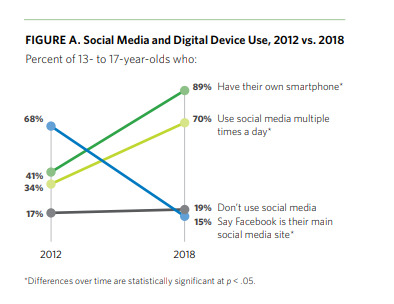
On one study done with teens from the ages 13-17 on common sense media, we can see that the rate of accessibility to using social media has increased by twice its percentage since 2012. With many minors having smartphones, it is safe to say that the rate of social media usage has also increased by a little over twice its own percentage. Along with the higher usage of social media comes with the beneficial emotions that the teens exude. Many of the teens in the study had better reactions to the increase usage of social media in their day to day lives.
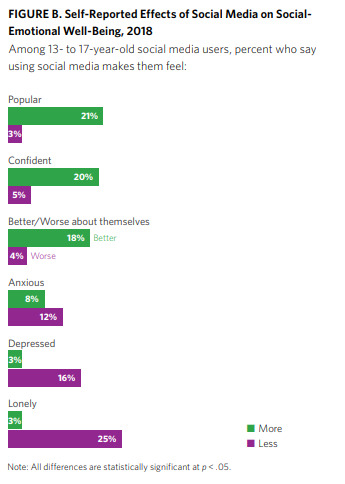
Surprisingly, many of the emotions that the teens felt were more positive than negative, with the only negative one being anxious by 4%. We can see that the difference in loneliness is the most significantly apart, representing how the vast platforms on social media has lead to many different ways to communicate.

With the decrease of usage of Facebook and the increase in usage in other platforms such as Instagram and Snapchat, we can see a change that the teens are choosing platforms that are easier to send photographic communication. The simplicity of Snapchat has also impacted younger generations, unlike Facebook which has been around for as long as some of these teens toddler ages. Facebook has a more forum feel, which may be intimidating for younger generations as most young people would like to live more in the moment.
The usage of social media also has trends for adults as well.
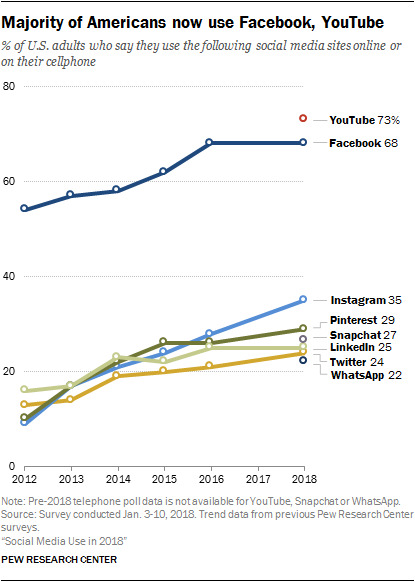
Adults have been more socially active on Facebook and YouTube particularly. This may been to the familiarity that many adults have with the websites that had rocketed pre-2010. According to the article, “[...] a majority of users (59%) say it would not be hard to stop using these sites, including 29% who say it would not be hard at all to give up social media.” Which is surprising as the the same sample had also stated that the majority would visit these sites several times a day.
The primary negative issues that the Pew Research Center had stated were the issues that many adults had with the concern of their privacy while on these sites. The article shows the concerns people have by stating, “Despite using them for a wide range of reasons, just 3% of social media users indicate that they have a lot of trust in the information they find on these sites. And relatively few have confidence in these platforms to keep their personal information safe from bad actors.” This could explain why many adults would be more able to give up social media.
The primary negative issues that Common Sense Media has are not all that negative, but they show that teens are starting to prefer social media connections slightly over their real life ones.
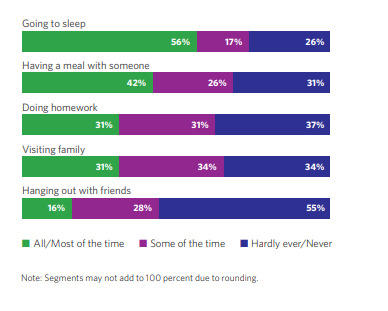
This chart shows the likelihood of teens putting away their phones during certain occasions. It is a very common issue, and is almost a stereotype that is depicted in entertainment of your average teenager who will not put their phone away when they’re talking to others. The reality is that it is not as drastic as these depictions, unless they are with friends. That would make sense since social media can arise discussion between friends.
I think the most notable finding between the two was the emotions that come into play when using social media for teens. I would’ve believed that in the digital age there would be more cyber-bullying or pressure due to all the news that has circulated on these topics. I would like it if they had a definition on what the teens considered cyber-bullying to show if the trends that were happening in the early social media age with cyber-bullying are still happening today.
2 notes
·
View notes